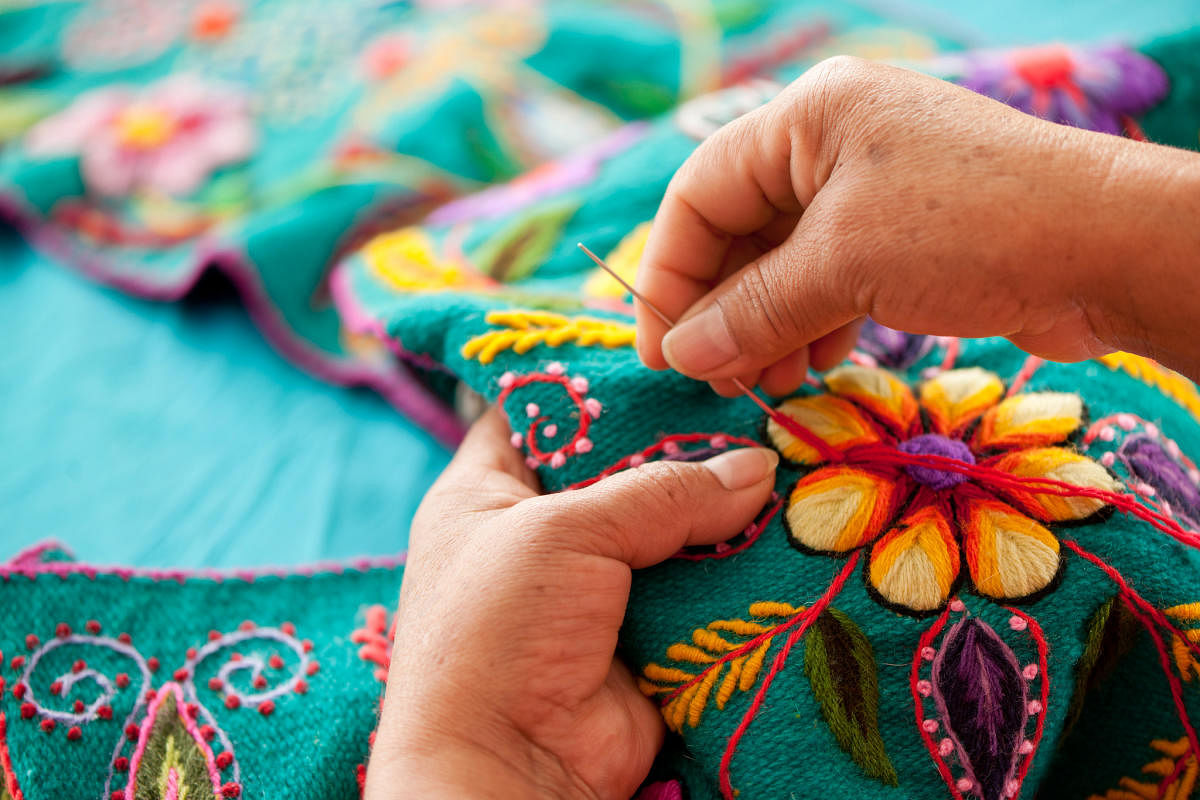I am looking at a lively market scene. Luscious fruits lining stalls, women in voluminous skirts with baskets, children playing, and the Andean sun setting in the distance. They are actually the details on an applique quilt called arpillera. This 3D textile art from the Peruvian Andes has a bewildering number of small images crafted from recycled bits of fabric. It's derived from the Spanish word for sackcloth or coarse cloth. People started making arpilleras in Chile as a form of political protest against the oppressive dictatorship of General Augusto Pinochet. Their pictures showed the violence, torture and repression they faced from the regime.
Today, arpilleras are created in a number of co-operatives located in the shantytowns of poor families that surround the capital city of Lima. It gives the women some extra income and a chance to express their creativity. There's a whole lot of details that go into the making of these quilts: I see scraps of fabric, vinyl and felt; even bits of straw and raffia. The arpilleras deal with common themes the women are familiar with, ranging from planting and harvesting potatoes and corn to stories of spinning and weaving wool, tending llamas and sheep to weddings and fiestas.
Pretty & sustainable
Peru has a wide variety of the most exquisite and colourful arts and crafts. Weaving is one of the most important crafts - my local guide in Cusco, Alex Medina, tells me that as Quechua was not a written language, weaving was the means of passing on knowledge and narrating stories to the next generation. Every handcrafted object had a meaning: ceremonial cups were not just for drinking, the patterns on clothes were not random motifs. The craft was an integral part of the cultural identity of the Peruvian people.
As I travel through the Peruvian Amazon, I see a host of sustainable products made from plants, roots, seeds and fibres with natural dyes. There are woven baskets and fans, tribal jewellery made from seeds and beads, straw animals and birds crafted from the fibre of the porcupine palm. I watch women selling mats and runners with shipibo embroidery in geometric black and red patterns. Shipibo is one of the ethnic groups of tribes in the Peruvian Amazon. It is said that the patterns are created by women after listening to songs of a local healer, which are influenced by the use of the hallucinogenic substance, ayahuasca. Each design starts in the centre and spreads out, portraying a map of the cosmos!
One of the most eye-catching Peruvian crafts that I see in craft galleries and markets around the country are retablos. This Andean folk art has miniature altar boxes with three-dimensional scenes from Biblical nativity, to stories of local agriculture, festivals and celebrations and musical instruments; market scenes and healing ceremonies... "This originated from Christian church art when Christian warriors carried small portable altars for worship when they travelled far away from their local churches," explains Mari, a Welsh lady who has the widest selection of Peruvian folk art at her gallery in Barranco, the Bohemian neighbourhood of Lima.
Many of these altar boxes have nativity scenes with local motifs - llamas instead of camels, and Jesus and Mary in indigenous garb. The doors and exteriors usually feature brightly painted flowers. There are also scenes from markets, celebrations and agricultural scenes. Usually, the figures are made out of a paste of gypsum, clay and potato flour. Over the years, the retablos have also become a mode of social commentary portraying terrorism, peasant slaughter, armed fights and political situations.
Folk favourites
Ayacucho in South Central Peru is the capital of folk art and crafts of the country from where a zillion crafts emanate. My favourite is the red clay churches with tiny figures peering out of windows and spilling out of balconies that are crafted to be installed on roofs of new homes to bless and protect the people from evil spirits, and are made in Quinua. Handcrafted in clay, they are then fired and painted in muted brown and beige.
Another craft that is prevalent is the wooden tablos of Sarhua that are painted with natural pigments from top to bottom and gifted to people with new homes or to a new member of the family. The story is told horizontally, from top to bottom. The tablos show the history of the family with portraits of the homeowners' families and friends, travelling musicians or harvests. The long plank shape was meant to fit on the ceiling of a family home, under the main roof beam.
Woven cloth was the most prized possession in ancient Incan civilisation. And today, weaving is the most popular craft that I see all over the country. Symbolism is very important in weaving with motifs used like puma, fish, sun and moon. The colours are created using natural plants and insects ground up to make the dye which is boiled in these pots. After drying, it is ready for the backstrap looms which we saw all over the country.
The Incas associated gold with the sun. Gold and silver pieces were used during the Spanish colonial period to decorate church altars and houses of the wealthy. Workers mostly came from Spain and Italy. Most of the jewellery that I see has references to spiritual connections of the Incas - with icons of Inca cosmology such as chakana, which represents the constellation of the Southern Cross, pachamama (Earth) and inti (Sun). Hojalatera or tinwork was once called the poor man's silver and was in danger of disappearing due to the advent of plastic items. But the artisans started making decorative pieces from recycled tin like candlesticks, Christian crosses and mirror frames instead of utilitarian products like buckets, and it's now a flourishing market here.
